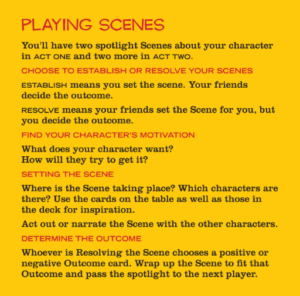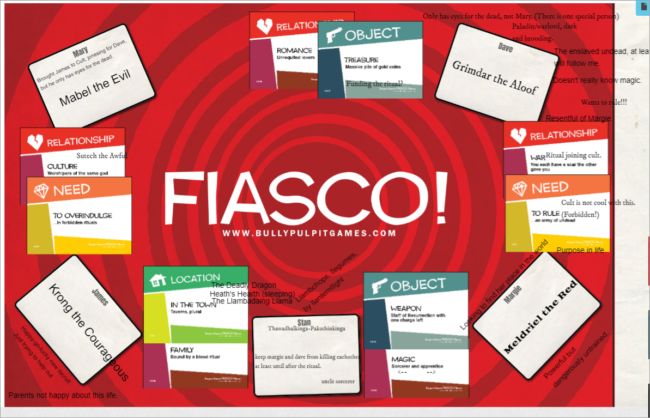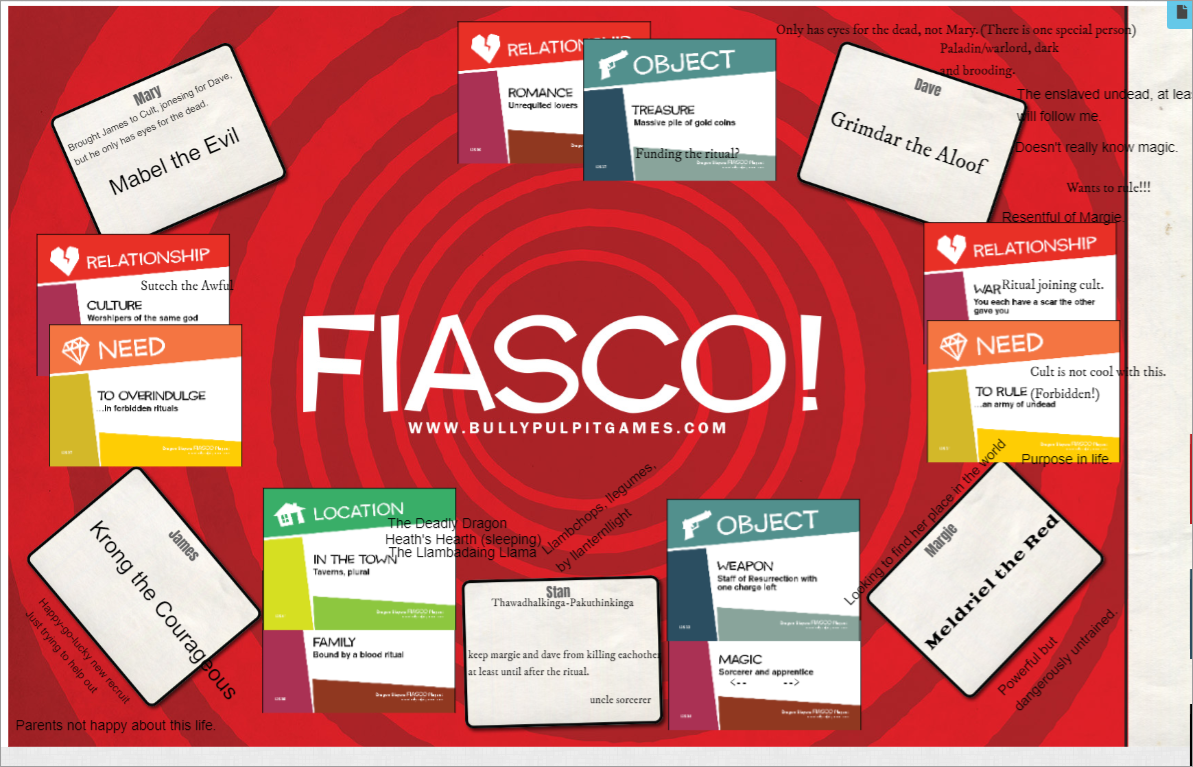Our regular Friday night D&D game needed a couple of fill-ins while a chunk of the folk were out of town. So, after last week’s Killer Ratings game, I thought we finally try Fiasco.
 It didn’t work out great for us, but I think that was more on us than on the game. So let’s take a look.
It didn’t work out great for us, but I think that was more on us than on the game. So let’s take a look.
The Game
Fiasco is a key — and one of the oldest — player in the “RPG as Improv with Light Rule Structure” games. It’s designed to give us the opportunity to play ordinary people with big ambitions and weak impulse control getting themselves into trouble and ending up in a likely very bad place … but with plenty of dark humor along the way. As many people have put it, it’s like playing a Coen Bros. movie in the time it would take to watch one.
The newest incarnation of the game has replaced stacks of dice and lookup tables with “engine” card sets, which seems to work well. You start out with a set of “playset” cards which are used to (a) establish the general parameters of the setting (a suburban town, a shopping mall, a D&D village), and (b) start building the relationships between the player’s characters. These include some key locations, maybe some objects, and definitely some needs that will drive things forward.
Once relationship et al. cards have been played down, you have a conversation around the table about what they all really mean. That Family Member relationship, is that biological, or adopted, or ritual? That Bully and Victim card — which person is which? Who’s actually jonesing for the WW2 pistol, and why? Start fleshing out those relationships to get things started — but allow for some discovery during the game, too. I wouldn’t necessary suggest keeping secrets (others can’t play to your story if you have it hidden), but new facets of the relationships, characters, and situation should come up during play.

Once the setting and players have been established, then we get two Acts of two spotlight Scenes per player each (so each character will end up in a spotlight Scene four times during the game, plus playing a supporting role in other Scenes). In a spotlight Scene, a player can either Establish the Scene (declare who’s there besides themselves, what’s the setting, and what are they trying to get out of it), or Resolve the scene (take a Scene devised by the other players involving their character, and determine as it goes along if it’s going to have a Positive or Negative Outcome). Scenes should last a few minutes, draw from the story set so far and the relationship elements on the board, and go from there.
Between the two Acts there is a Tilt, which brings in some new elements to make a hopefully already shaky outcome explode even more spectacularly.
At the end of Act Two, each player, based on the Outcome cards they have collected, get an Aftermath card of lesser or greater disaster, and narrates whatever happened to their character, short- or long-term.
The three playsets that come in the box (or at least my virtual box) are:
- Poppleton Mall (fun and drama and maybe drug dealing and Satanism at a local shopping mall)
- Tales from Suburbia (fun and drama in the burbs, with still more drug dealing and crime and infidelity simmering beneath the BBQ-friendly surface)
- Dragonslayers (post-D&D quest adventurers back at the tavern, eyeing that gold they just picked up).
Playsets are not a one-and-done. Depending on the characters, the cards that come out, and the mix and imagination of the players, a given playset could be used many times — though not as an ongoing campaign, mind you (rarely, I sense, is there enough of the setting or the characters left standing after a game to make that viable).
The rules themselves are relatively simple, but was a little difficult to get a good feel for how the game actually worked without actually watching some play videos. Three I recommend:
The game also comes with a “Let’s Not” safety card, in case action starts going down directions that make any player a bit too uncomfortable.
Players are definitely urged to lean into the dark humor and risk-taking and ignoring of possibly bad consequences to decisions being made. While the story may be about the characters competing with each other (even ones that are allies), the game itself seems to almost be the players vs. the characters — trying to get folk into trouble, not in a mean way to other players, but in a way that would make a good film.
(The film model is useful in framing scenes, too. A scene should not be, “Bob goes to the store to buy milk,” because that’s boring. “Bill goes to the store to buy milk he’s gonna see Susan and decide to confront her about Pat” is a lot more interesting, and has the stakes built into it.)
Fiasco is deservedly famous for its groundbreaking use of the players and their character interactions to drive the story. It’s GMless, though “The Person with the Game” will probably need to help explain it and guide players through the first time.
Definitely something you should consider for your gaming group if you’ve not already, and if it’s a group that loves the RP part of RPGs.
The home page for the game can be found here, but it’s available in a lot of places, including as a VTT implementation on Roll20 …
Roll20 Implementation — Fiasco for VTT
The core game (with the three playsets mentioned above) runs $20 in the Roll20 Marketplace. Expansion sets of eight additional playsets are available for $35 (there is a Starter Bundle with a total of 11 playsets for $33).
As a card deck game, the Roll20 implementation should work well. It comes packaged with play mats (on the map level) for three, four, and five players (thought the spacing on the five player mat was pretty uneven).
You also get a deck for each playset, and then separate decks for Positive Outcome, Negative Outcome, and Aftermath cards.
The (tabletop-based) game rules get loaded into the Compendium (a manual step you have to take to include it), and there are some stub handouts in the Journal as an outline for differences in Roll20. Most of these have to do with the card-playing mechanics of the VTT. If you’ve not done card decks in Roll20, do some practicing beforehand to see how dealing, viewing, playing, and clearing cards actually works.

I actually wasn’t wowed by the rules breakout — Roll20’s compendium is not always easy to use, and their organization is not great — so I ended up copying the (limited rules) over into the Journal, broken out more logically (to me), cross-referenced, and basically supporting all the information I got from the rules and from watching gameplay videos. Took me a couple of hours, so not a huge hill to climb there for GMs who want to do similarly.
Within the bounds of Roll20’s cardplay mechanics, the game worked well. Those mechanics are sometimes a bit awkward, and limitations on what Players vs GMs can do meant I got a suggestion from a friend that I make everyone a GM. I didn’t (because I thought that would make for more potential mechanics chaos), and it didn’t bite us — but, then, we didn’t actually get a full game completed, so it may have been more of a problem later.
One element that a VTT lends itself to is scribbling notes on the board itself — character names, info about them, discovered motivations, what the cards mean in this context, etc. I highly encourage the practice.
I would also add a recommendation, if playing on a VTT, that if you don’t use video normally you find a way to do so for Fiasco. So much of the game is bound up in personal interaction that the additional “data channel” of facial expressions and the like are even more important. It can also help see if people are quiet because they are nodding off, not engaged, or just unsure what to say.
How did it go for us?
Not … as well as I would have liked. Here’s a capture of the tabletop when we got as far as we’d gotten.

One problem we had was that the game just ran too long. We took close to 3 hours to get to the end of Act One, which became problematic for our East Coast player. While I would expect (and was warned) that the game could run longer than usual the first time out, that seemed excessive. But I’m unsure that’s actually the game’s fault.
- Did I talk too much, going through rules? Maybe.
- The players struggled a bit with the whole Scenes mechanic: coming up with a scene idea in the first place, limiting (or not) the other players involved, identifying what they wanted (in a meaningful fashion). People tended to come up with mechanical scene ideas (“I want to get everyone together for dinner”) rather than the emotional stakes (“My family never ate together, and if I can just get my friends around the table it will all be great.”). (Again, framed another way, is the Scene worth a scene in a movie?)
- Some Scenes ran on too long. If the goal is really a few minutes each, we had some that were several.
- We had a bit of difficulty determining Positive vs Negative Outcomes, especially when a player was doing the Resolving, and went in wanting that result.
- I have a sense that, even though we threw around a lot of great relationship ideas, we didn’t necessarily have a sufficient grounding in them by the time we started play, so that some of those encounters and ideas never paid off, and others got changed at the last moment.
- We play on Friday nights, and that’s always a rough call — end of a long week and, again, one player off two time zones deeper into the night. that might have lowered the energy level for a game that really encourages energy.
- Our group is mostly introverted and, to a large degree, conflict-averse. Not so pathologically that a game like Fiasco — which desires big characters and getting ourselves and each other into trouble — is impossible, but it is a bit more of a lift.
We played the Dragonslayers playset. I thought that would work well as we were doing this in lieu of D&D, but in retrospect I wonder if it added one more layer of worldbuilding that we needed to struggle through.
Ultimately, we ended up with a D&D party that was actually an offshoot of an evil cult, with a goal to raise an army of the undead for the edgelord type I was playing (we were an offshoot because, obviously, the cult didn’t want just any Tom, Dick, or Grimdar to be raising armies of the undead). I was supported in that goal (kind of?) by the cult’s recruiter/cheerleader (who had an unrequited love for me), an eager young hero recently joined to the cult, and a sorcerer and his apprentice and their one-charge-left staff of resurrection. So some real possibilities there.
And that said, we did come up with some good bits — flashbacks, and a dream sequence, all of which had some interesting elements to them. One player also made a good move and framed a scene, not as our sitting down to dinner, or doing a dress rehearsal for the forbidden ritual after dinner, but our post-dress rehearsal review around the table — which allowed us just to vamp ideas about what happened and our reaction to them.
As it was, we pulled the plug at the end of Act One, due to time and no immediate opportunity to finish the game over the weekend. Players did indicate they could see how this all (raising an army of the dead on behalf of one of the players) was going to play out very poorly for all concerned. So that was something.
Definitely want to try it again, though, maybe with one of the other playsets. With the holiday season coming up, we may get the opportunity.

